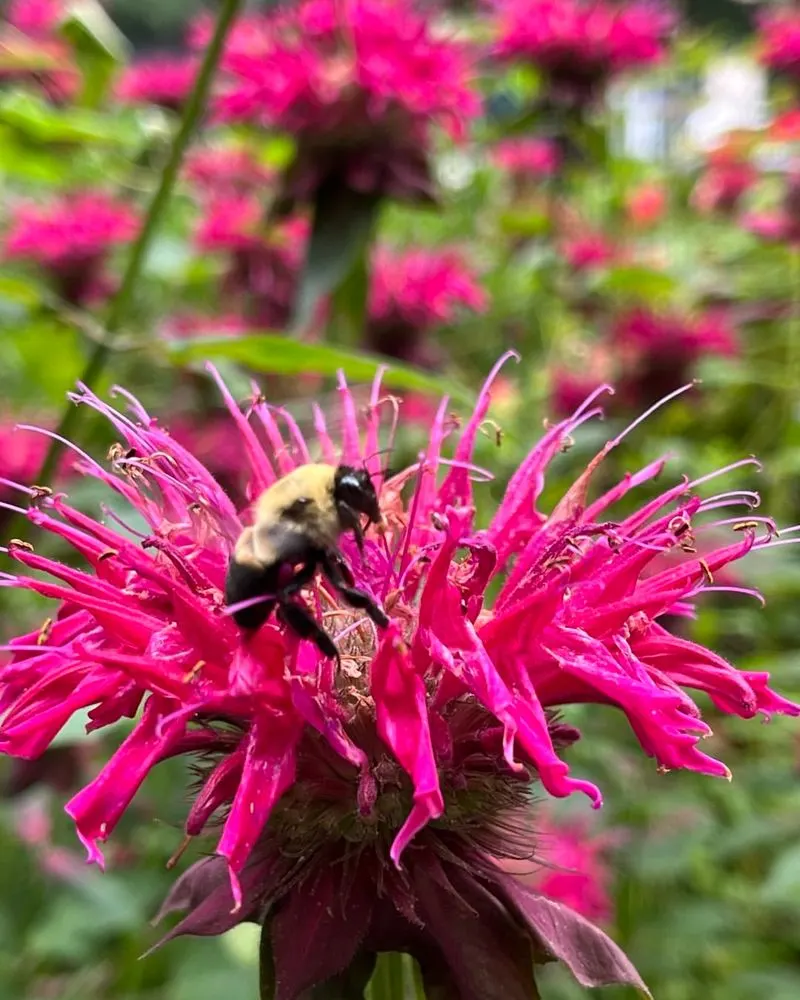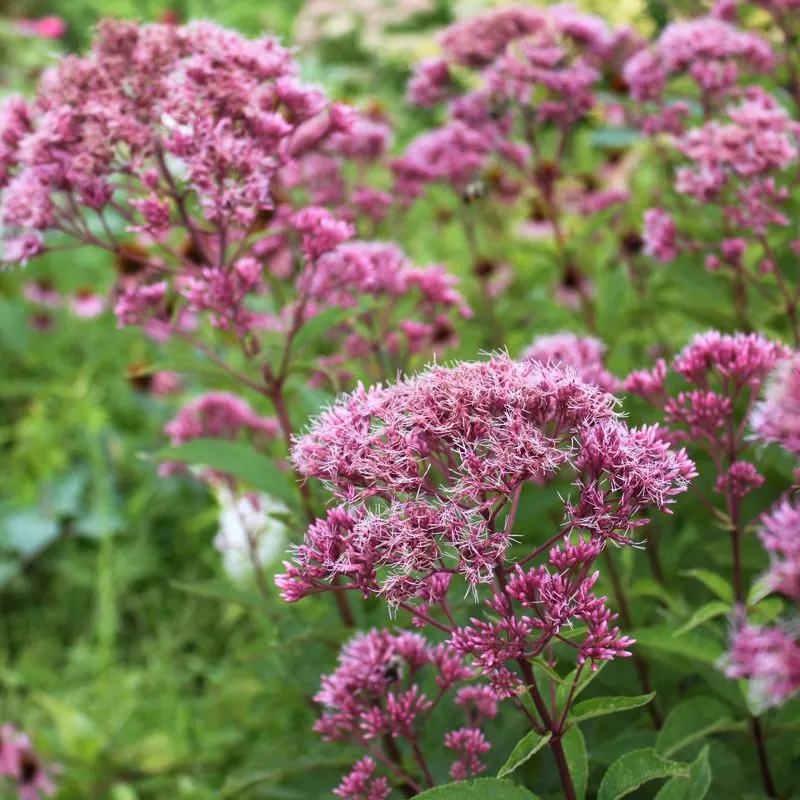Transforming your yard into a haven for birds starts with the right plants. Native plants are especially effective, as they provide the food, shelter, and nesting opportunities that local bird species need to thrive.
Beyond supporting wildlife, these plants also enhance the beauty and ecological health of your garden.
In this list, we’ll highlight 13 native plants that attract and support a variety of bird species.
By incorporating these into your landscape, you can create a vibrant, bird-friendly environment that’s both beneficial to wildlife and a joy to watch year-round.
Purple Coneflower

This striking perennial is known for its large, daisy-like flowers with purple petals and a spiky central cone. Birds, especially finches, love its seed heads, making it a natural feeder. Purple coneflowers thrive in sunny spots and can tolerate drought, making them low-maintenance.
Their blooms add a splash of color to any garden, attracting not only birds but also butterflies and bees. The plant’s resilience and beauty make it an excellent choice for those looking to create a bird-friendly environment. Plant them in clusters for a more dramatic effect and watch your garden come alive.
Serviceberry

Serviceberry bushes produce juicy berries that are a favorite among birds like robins and cedar waxwings. These attractive shrubs or small trees bloom with white flowers in spring, providing nectar to pollinators. In autumn, their leaves turn vibrant shades of red and orange, adding seasonal interest.
The berries ripen in early summer, offering a nutritious snack for birds and humans alike. Serviceberries are versatile, growing well in both sun and partial shade. They can be used as ornamental plants in landscapes, bringing both beauty and wildlife to your yard.
Cardinal Flower

Cardinal flowers are famous for their brilliant red blooms that hummingbirds find irresistible. These native perennials prefer moist conditions, often thriving near water sources.
Their tall spikes of flowers bloom in late summer, providing vital nectar during this time. Despite their delicate appearance, cardinal flowers are quite hardy and can adapt to various garden settings. Incorporating them into your landscape can attract not just hummingbirds but also butterflies. They are a perfect choice for those aiming to add color and wildlife interest to damp or shaded areas of the garden.
Black-eyed Susan

These cheerful flowers are a staple in many bird-friendly gardens. Their bright yellow petals and dark brown centers are not only visually appealing but also serve an important ecological role.
Goldfinches and other seed-eating birds enjoy their seeds, which are abundant in late summer to fall. Black-eyed Susans thrive in full sun and are drought-tolerant, making them an easy addition to most gardens. They bloom profusely, attracting butterflies and bees, and provide excellent cut flowers. Group them together for a stunning visual impact and to maximize their attraction to wildlife.
Elderberry

Elderberries are not only popular for making jams and wines but also as a food source for birds. Their clusters of tiny, dark purple berries attract a variety of bird species, including thrushes and waxwings. Elderberry plants are adaptable, growing well in both sun and partial shade.
In spring, they produce creamy white flowers that are visually striking and attract beneficial insects. By autumn, the berries are ripe, providing essential nutrition for migrating birds. Elderberry bushes can be planted as hedges or natural screens, offering both beauty and a bounty of food for wildlife.
Bee Balm

Bee balm, with its vibrant palette of red, pink, and purple flowers, acts as a magnet for hummingbirds and pollinators. This fragrant perennial thrives in sunny locations and can tolerate a variety of soil conditions. The flowers appear in midsummer, offering nectar when few other plants are in bloom.
Besides attracting hummingbirds, bee balm is also favored by bees and butterflies. Its aromatic leaves can be used to make tea, adding to its appeal. Planting bee balm in groups will enhance its visual impact and increase its effectiveness in attracting wildlife.
Redbud

The early spring blossoms of redbud trees add a splash of pink to any garden.
These small trees or large shrubs are known for their beautiful heart-shaped leaves and vibrant flowers that attract pollinators. Birds are drawn to the tree’s seeds and insects found around its foliage. Redbuds are versatile, thriving in a variety of soil types and conditions.
Their striking appearance makes them excellent focal points in garden design. The tree’s adaptability and the habitat it provides for birds and insects make it a valuable addition to nature-friendly landscapes.
Holly

Holly bushes are a classic choice for attracting birds, particularly in winter when food is scarce. Their bright red berries and dense evergreen foliage provide both food and shelter.
Many bird species, such as thrushes and robins, rely on holly berries as a valuable food source during the colder months. Holly plants are hardy and can tolerate a range of soil conditions. Their spiky leaves deter browsing animals, making them low-maintenance.
Whether used as hedges or stand-alone specimens, holly bushes add year-round interest and support wildlife in your garden.
Wild Strawberry

Wild strawberries offer sweet treats for both birds and humans. These low-growing plants produce small, fragrant berries that are irresistible to many bird species.
Wild strawberries thrive in sunny spots and can spread quickly, making them excellent ground cover. Their white flowers appear in spring, providing nectar to pollinators before the berries develop. Besides being a food source, the plants create a lush green carpet that can help with erosion control.
Planting wild strawberries is a delightful way to enrich your garden’s ecosystem while enjoying a tasty harvest.
New England Aster

New England asters bring vibrant shades of purple and pink to the garden in late summer and fall. These perennials are a favorite among migratory birds, which feast on their seeds.
The lush blooms also attract bees and butterflies, providing nectar late in the season. Asters prefer sunny locations and can grow in various soil types, making them a versatile choice for many gardens.
Their tall, sturdy stems add structure, while their abundant flowers create a colorful spectacle. Asters can be used to enhance borders or as part of a wildflower meadow.
Winterberry

Winterberry bushes are celebrated for their bright red berries that stand out in winter landscapes. These deciduous hollies drop their leaves in fall, revealing clusters of berries that persist until spring.
Birds, including cedar waxwings and finches, flock to these bushes for food during the colder months. Winterberries thrive in wetland areas but can adapt to garden settings with adequate moisture.
Their striking appearance in winter adds visual interest when few other plants are in bloom. Plant them in groups for maximum impact and to provide ample food for visiting birds.
Joe-Pye Weed

Joe-Pye Weed is a tall, native perennial known for its clusters of pinkish-purple flowers. These blooms are a magnet for pollinators, attracting butterflies, bees, and even hummingbirds. Birds benefit from the seeds produced in the fall.
Joe-Pye Weed prefers moist, well-drained soils and can thrive in both sun and partial shade. Its height and floral display make it a fantastic backdrop in mixed borders or naturalistic plantings. By including Joe-Pye Weed in your garden, you provide essential resources for wildlife while enjoying its impressive stature and beauty.
Chokecherry

Chokecherries are a valuable addition to bird-friendly gardens, offering clusters of dark red berries that many bird species relish.
These small trees or large shrubs are adaptable to various conditions, thriving in sun or shade. In spring, they produce fragrant white flowers that attract pollinators. By summer, the berries are ripe and ready for birds to enjoy.
Chokecherries also provide cover and nesting sites, enhancing their ecological value. They are ideal for naturalistic landscapes, hedgerows, or woodland gardens, contributing to biodiversity and the visual appeal of your outdoor space.

